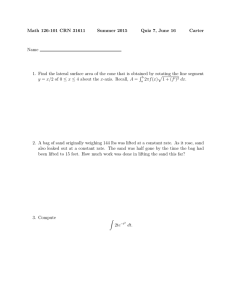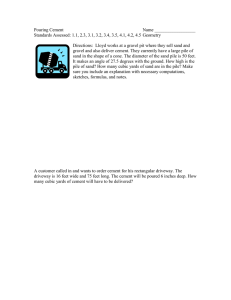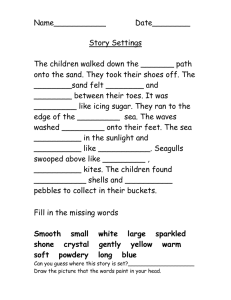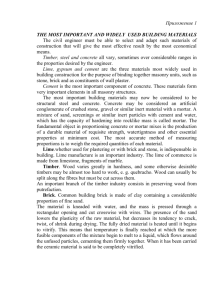IRJET-Experimental Study on Partial Replacement of Cement by GGBS and Fine Aggregate by Robo Sand for M25 Grade Concrete
advertisement
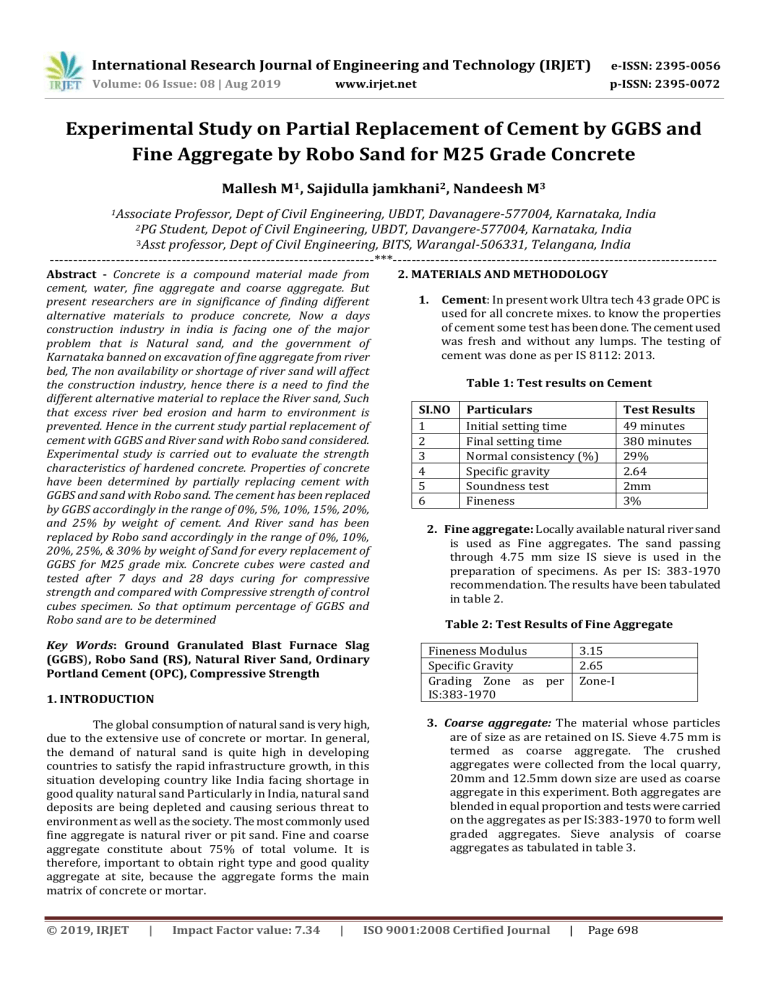
International Research Journal of Engineering and Technology (IRJET) e-ISSN: 2395-0056 Volume: 06 Issue: 08 | Aug 2019 p-ISSN: 2395-0072 www.irjet.net Experimental Study on Partial Replacement of Cement by GGBS and Fine Aggregate by Robo Sand for M25 Grade Concrete Mallesh M1, Sajidulla jamkhani2, Nandeesh M3 1Associate Professor, Dept of Civil Engineering, UBDT, Davanagere-577004, Karnataka, India Student, Depot of Civil Engineering, UBDT, Davangere-577004, Karnataka, India 3Asst professor, Dept of Civil Engineering, BITS, Warangal-506331, Telangana, India ---------------------------------------------------------------------***--------------------------------------------------------------------2PG Abstract - Concrete is a compound material made from cement, water, fine aggregate and coarse aggregate. But present researchers are in significance of finding different alternative materials to produce concrete, Now a days construction industry in india is facing one of the major problem that is Natural sand, and the government of Karnataka banned on excavation of fine aggregate from river bed, The non availability or shortage of river sand will affect the construction industry, hence there is a need to find the different alternative material to replace the River sand, Such that excess river bed erosion and harm to environment is prevented. Hence in the current study partial replacement of cement with GGBS and River sand with Robo sand considered. Experimental study is carried out to evaluate the strength characteristics of hardened concrete. Properties of concrete have been determined by partially replacing cement with GGBS and sand with Robo sand. The cement has been replaced by GGBS accordingly in the range of 0%, 5%, 10%, 15%, 20%, and 25% by weight of cement. And River sand has been replaced by Robo sand accordingly in the range of 0%, 10%, 20%, 25%, & 30% by weight of Sand for every replacement of GGBS for M25 grade mix. Concrete cubes were casted and tested after 7 days and 28 days curing for compressive strength and compared with Compressive strength of control cubes specimen. So that optimum percentage of GGBS and Robo sand are to be determined Key Words: Ground Granulated Blast Furnace Slag (GGBS), Robo Sand (RS), Natural River Sand, Ordinary Portland Cement (OPC), Compressive Strength 1. INTRODUCTION The global consumption of natural sand is very high, due to the extensive use of concrete or mortar. In general, the demand of natural sand is quite high in developing countries to satisfy the rapid infrastructure growth, in this situation developing country like India facing shortage in good quality natural sand Particularly in India, natural sand deposits are being depleted and causing serious threat to environment as well as the society. The most commonly used fine aggregate is natural river or pit sand. Fine and coarse aggregate constitute about 75% of total volume. It is therefore, important to obtain right type and good quality aggregate at site, because the aggregate forms the main matrix of concrete or mortar. © 2019, IRJET | Impact Factor value: 7.34 | 2. MATERIALS AND METHODOLOGY 1. Cement: In present work Ultra tech 43 grade OPC is used for all concrete mixes. to know the properties of cement some test has been done. The cement used was fresh and without any lumps. The testing of cement was done as per IS 8112: 2013. Table 1: Test results on Cement SI.NO 1 2 3 4 5 6 Particulars Initial setting time Final setting time Normal consistency (%) Specific gravity Soundness test Fineness Test Results 49 minutes 380 minutes 29% 2.64 2mm 3% 2. Fine aggregate: Locally available natural river sand is used as Fine aggregates. The sand passing through 4.75 mm size IS sieve is used in the preparation of specimens. As per IS: 383-1970 recommendation. The results have been tabulated in table 2. Table 2: Test Results of Fine Aggregate Fineness Modulus Specific Gravity Grading Zone as per IS:383-1970 3.15 2.65 Zone-I 3. Coarse aggregate: The material whose particles are of size as are retained on IS. Sieve 4.75 mm is termed as coarse aggregate. The crushed aggregates were collected from the local quarry, 20mm and 12.5mm down size are used as coarse aggregate in this experiment. Both aggregates are blended in equal proportion and tests were carried on the aggregates as per IS:383-1970 to form well graded aggregates. Sieve analysis of coarse aggregates as tabulated in table 3. ISO 9001:2008 Certified Journal | Page 698 International Research Journal of Engineering and Technology (IRJET) e-ISSN: 2395-0056 Volume: 06 Issue: 08 | Aug 2019 p-ISSN: 2395-0072 www.irjet.net Table 3: Test results of coarse aggregates Specific Gravity Shape Size Size 3. METHODOLOGY: 2.75 Angular 20mm and 12.5mm down 4. Ground Granulated Blast Furnace Slag (GGBS) : GGBS is obtained by quenching molten iron slag (a by-product of iron and steel-making) from a blast furnace in water or steam, to produce a glassy, granular product that is then dried and ground into a fine powder.For our research work GGBS used is brought from HULMANI CONSTRUCTION PLANT. The properties of GGBS are tabulated in tabte 4. Table 4: Test Results of GGBS Colour Appearance Fineness Specific Gravity white fine powder 3% 2.7 5. Robo Sand (RS): Robo sand is the sand manufactured in the stone quarries. Robo Sand is collected from crushing unit.(ABM PLANT). Robo sand was used as a replacement material for fine aggregate in the current experiment.The test results of Robo sand is tabulated in table 5. Table 5: Test results of Robo sand Colour Fineness modulus Specific Gravity Off white 3.04 2.61 7. Super Plasticizer: In the present experimental work conplast SP 430 is used obtained from Forsoc chemicals (Inda) pvt. Ltd. Its advantage is improved workability, Increased strength, Hight cohesion and free from chloride.Its specific gravity is 1.220 to 1.225 at 30°C | Impact Factor value: 7.34 Table 6: Combination of Replacement ratios of GGBS and Robo Sand: SL. NO 6. Water: Water should be easily available and it should be clear and tap water also satisfactory to mix the ingredients and it should not be any alkali and should be free from chlorides of calcium and magnesium. Portable water available from laboratory which satisfies the drinking standard is used for mixing and curing. The PH value should not less than 6. The water used for casting and curing of concrete should satisfy as per IS 4562000. © 2019, IRJET The basic tests are conducted on various materials like OPC43 grade cement, GGBS, fine aggregate, coarse aggregate and Robo sand to check their suitability for making concrete. The Coarse aggregates and Fine aggregates were first mixed together for about 3 minutes and cement is added to make dry mix. Then water with super plasticizer is added to dry mix and continued mixing for another 3-4 minutes until adequate mixing was done. The fresh concrete was then cast in 3 layers to a concrete mould of size 150x150x150mm immediately after mixing without delay. Each is tamped 25 strokes with tamping rod. The casted cubes were left without disturbed in labouratory along wit mould for 24 hour. Then cubes were demoulded after 24 hours and were put in curing tank for 28 days of curing. Experimental study is conduced to evaluate the strength characteristics of hardened concrete. Properties of concrete have been assessed by partially replacing cement wit GGBS and Natural sand with Robo sand. The cement has been replaced by GGBS accordingly in the range of 0%, 5%, 10%, 15%, 20%, & 25% by the weight of cement. The natural sand has been replaced by Robo sand accordingly in the range of 0%, 10%, 20%, 25%, & 30% by weight of Natural sand for every replacement of GGBS for M25 grade mix. Concrete cubes were tested after 7 days ad 28 days curing for compressive strength and compared with conventional concrete specimens. So that optimum percentage of GGBS and Robo sand is to be determined. | 1 2 3 4 5 6 Replacement of GGBS For Cement in % 0 5% 10 % 15% 20% 25% Replacement of Robo sand forfine aggregate in % 0 0 0 0 0 0 10 10 10 10 10 10 20 20 20 20 20 20 25 25 25 25 25 25 30 30 30 30 30 30 For each iteration, two sets of cubes (6 specimens) were casted. One set of cubes were tested for compressive strength after 7 days of curing and other set of cubes were tested after 28 days of curing. 4. MIX DESIGN: The M25 grade of concrete is adopted for the present Experimental work. Detailed mix proportion is obtained as per IS: 10262-2009. ISO 9001:2008 Certified Journal | Page 699 International Research Journal of Engineering and Technology (IRJET) e-ISSN: 2395-0056 Volume: 06 Issue: 08 | Aug 2019 p-ISSN: 2395-0072 www.irjet.net Table 7: Mix proportion Ingredients Water in liters Cement in Kg Optimum Compressive strength of concrete: Natural River sand in Kg Coarse aggregate in Kg 20 mm (50%) 12.5 mm (50%) Quantity 166.4 350.46 625.08 632.6 632.6 Mix ratio by weight W/C= 0.475 1 1.792 1.805 1.805 The results of compressive strength of concrete cubes for 7 days and 28 days are tabulated for varying % replacement of cement by GGBS & varying % replacement of Fine aggregate(Natural river sand) by Robo sand for optimum mix. It is observed that the optimum compressive strength for 7 days & 28 days are observed for 20% of replacement of the cement by GGBS and 25% of replacement of the Fine aggregate by Robo sand. 5. RESULTS AND DISCUSSIONS The Compressive Strength results of 7 days and 28 days are tabulated for different replacement ratios for M25 grade concrete mix. The results are tabulated as varying replacement for fine aggregate with restricted replacement for cement. Table 8: Compressive Strength of concrete SL. NO Mix (GGBS+RS) in % Compressive Strength (Mpa) 1 2 3 4 5 6 7 8 9 10 11 12 13 14 15 16 17 18 19 20 21 22 23 24 25 26 27 28 29 30 conventional 0+10 0+20 0+25 0+30 5+0 5+10 5+20 5+25 5+30 10+0 10+10 10+20 10+25 10+30 15+0 15+10 15+20 15+25 15+30 20+0 20+10 20+20 20+25 20+30 25+0 25+10 25+20 25+25 25+30 7 days 21.62 33.33 35.99 37.92 26.07 24.29 28.73 31.66 35.69 28.43 29.03 31.55 33.62 37.48 30.07 31.55 33.62 35.84 37.03 32.43 35.99 37.47 39.55 41.47 33.32 30.22 27.40 27.11 25.77 22.81 © 2019, IRJET | 28 days 32.29 34.29 38.21 41.32 28.73 30.07 33.62 35.99 40.29 30.22 32.27 35.85 37.77 40.58 31.84 36.14 38.07 41.77 43.39 33.18 39.25 45.18 47.37 52.14 36.44 35.84 33 32.88 29.92 26.22 Impact Factor value: 7.34 Compressive strength N/mm2 60 50 40 30 20 10 0 25% 25% 25% 25% 25% 25% Robo sand 7days compressive strength N/mm2 28days compressive strength N/mm2 Chart -1: Graph shows the Optimum compressive strength of concrete The concrete behavior is studied by partial replacement of cement by GGBS & Fine aggregate by Robo sand. The following Conclusions have been taken from the obtained results. 6. CONCLUSIONS In this study, For M25 Grade of concrete the mean target strength is achieved by partial replacement of cement by GGBS and Fine aggregate by Robo sand. From this experimental study, The optimum replacement ratio for M25 grade of concrete mix are 20% replacement of cement by GGBS and 25% replacement of fine aggregate by Robo sand, which gives 61% more compressive strength than the results of conventional concrete And target strength of M25 Mix. The experimental study has proved to be better way to disposal of industrial by product and waste such as Ground granulated blast furnace slag and Robo sand. By reinforcing the concrete with GGBS and Robo sand which are freely available, we can reduce the environment waste and its economical. | ISO 9001:2008 Certified Journal | Page 700 International Research Journal of Engineering and Technology (IRJET) e-ISSN: 2395-0056 Volume: 06 Issue: 08 | Aug 2019 p-ISSN: 2395-0072 www.irjet.net REFERENCES 1. 2. 3. 4. 5. 6. 7. 8. 9. Abhiyant Sharma et.al, Innovative application of fly ash and foundry sand in concrete mixes, International Journal for Research in Applied Science & Engineering Technology, Volume 5, Issue 7, July 2017, ISSN: 23219653. Brown, J.H. (1982) "The strength and workability of concrete with pfa substitution", International Journal for Research in Applied Science & Engineering Technology, Volume 6, Issue 7, Aug 2017, ISSN: 2321-9433. K. Srinivas Reddy, Replacement of natural sand with robo/artificial sand in specified concrete mix, International Journal for Research in Applied Science & Engineering Technology, Volume 6, Issue No. 9, 2016 M.D.Narendra et.al, An experimental study on high performance concrete partially replacing cement and fine aggregate with ggbs & robo sand, International Journal of Engineering Sciences & Emerging Technologies, Volume 7, Issue 5 Mar. 2015. ISSN: 22316604 Manjunatha M et.al, Performance Evaluation of Strength Properties of Concrete by Using Waste Foundry Sand, International Journal of Innovative Research in Science, Engineering and Technology, Vol. 5, Issue 4, April 2016, ISSN:2319-8753 N Sellakkannu, et.al, Experimental investigation on partial replacement of cement by ggbs, International Journal for Research in Applied Science & Engineering Technology, Volume 5, Issue 10, October 2017 ISSN: 2321-9653. O.Hemanth Rama Raju et.al, An Experimental Investigation on Partial Replacement of Cement with Metakaolin and Fine Aggregate with Robo Sand, International Research Journal of Engineering and Technology (IRJET) Volume: 04 Issue: 04 | Apr -2017 eISSN: 2395 -0056 p-ISSN: 2395-0072 P.Chandru, et.al, An experimental investigation on utilization of ground granulated blast furnace slag and waste foundry sand as a partial replacement in concrete, International Journal of Exploring Emerging Trends in Engineering,(IJEETE) Vol. 03, Issue 02, Mar-Apr, 2016. M.S Shetty Concrete technology, S,Chand & Co.Ltd, 1997, New delhi. IS: 9103-1999 (Reaffirmed 2004): “Concrete Admixtures-Specifications” BIS, New Delhi-2004. IS: 383-1970 “Specification for Coarse and Fine Aggregates from Natural Sources for Concrete” BIS, New Delhi-1970. IS: 8112-1989 (Reaffirmed 2005): Specification for 43 Grade Ordinary Portland Cement, BIS, New Delhi-2005. IS CODES: IS: 456-2000: Code of practice- plain and reinforced concrete, BIS, New Delhi-2000. IS:10262-2009 “Concrete Mix Proportioning – Guidelines” BIS, New Delhi-2009 IS:516-1959 “Methods of tests for strength of concrete” BIS, New Delhi-2004 IS: 1199-1959 “Indian Standards methods of sampling and analysis of concrete” BIS, New Delhi, India. © 2019, IRJET | Impact Factor value: 7.34 | ISO 9001:2008 Certified Journal | Page 701
